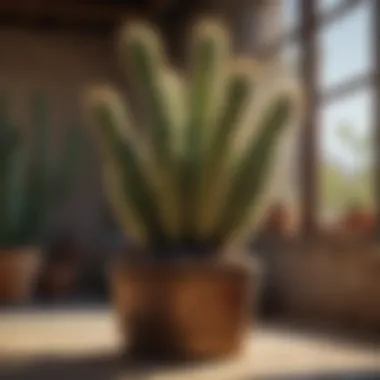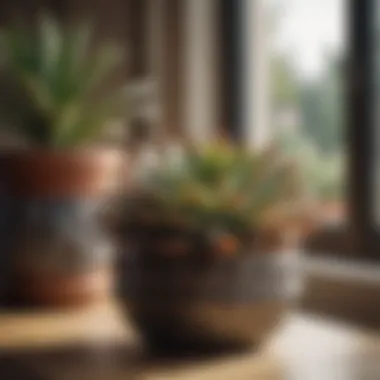Optimizing Indoor Plants for Arizona's Unique Climate Challenges


Materials:
In this section, we will outline all the necessary materials needed for optimizing indoor plants in Arizona climates. Ranging from soil to containers, these items are crucial for successful indoor gardening in arid conditions.
- Potting Mix: Opt for a well-draining mix suitable for desert plants. Use a blend of peat moss, perlite, and sand in equal parts.
- Containers: Select containers with drainage holes to prevent waterlogging. Ensure the pots are slightly larger than the plant's root ball.
- Plants: Choose resilient species like aloe vera, snake plant, or ZZ plant that thrive in low-moisture environments.
DIY Steps:
- Prepare the Potting Mix: Combine the peat moss, perlite, and sand in a large bucket. Mix thoroughly to ensure uniform consistency.
- Pot Selection: Fill the chosen containers with the potting mix, leaving some space at the top for planting.
- Plant Placement: Carefully remove the selected plant from its nursery pot and place it in the center of the container.
Technical Aspects:
To elevate the quality and uniqueness of your indoor gardening project, pay close attention to the technical aspects involved. From tools to timing specifics, these details can make a significant difference in the outcome:
- Watering Schedule: Establish a consistent watering routine based on the specific needs of each plant species. Avoid overwatering to prevent root rot.
- Light Requirements: Position your indoor plants in areas with ample natural light, preferably near south or west-facing windows.
DIY Project Process:
As you proceed with the indoor gardening project, ensure you follow a sequential approach to optimize your plants' growth and health. Here's a breakdown of the key steps involved:
- Watering Technique: Water the plants thoroughly until the excess drains from the bottom. Allow the soil to dry out slightly before the next watering session.
- Light Management: Rotate the plants regularly to promote even growth and prevent leaning towards the light source.
Troubleshooting Tips:
Despite diligent efforts, issues may arise during your indoor gardening endeavor. Be prepared to handle common challenges with these troubleshooting tips:
- Yellowing Leaves: Adjust the watering frequency if you notice yellowing leaves, as it could indicate both overwatering or underwatering.
- Pest Infestation: Inspect your plants regularly for signs of pests. Treat infestations promptly using natural remedies or insecticidal soap.
This detailed guide aims to equip you with the knowledge and skills required to optimize indoor plants for Arizona's unique climate. By following these meticulous instructions and technical insights, you can create a thriving indoor garden oasis in the midst of the desert.
Understanding Arizona's Climate


Arizona's climate is a particular focus of this article due to its arid and challenging conditions. Understanding the unique climate of Arizona is pivotal to successful indoor gardening. The state's dry and hot environment presents various obstacles for plant growth, making it essential to choose the right indoor plants that can thrive in such conditions. By grasping the intricacies of Arizona's climate, individuals can make informed decisions when selecting and caring for indoor plants, ensuring optimal growth and health.
In Arizona, the climate is characterized by scorching temperatures, minimal rainfall, and intense sunlight. These factors pose difficulties for traditional gardening, accentuating the importance of indoor plants that are well-suited to withstand such harsh conditions. By gaining a comprehensive insight into Arizona's climate, individuals can strategically plan their indoor garden to mitigate the challenges posed by the arid environment. Understanding the nuances of the state's climate enables individuals to make informed choices regarding plant selection, watering practices, and placement within their indoor spaces.
Furthermore, comprehending Arizona's climate empowers individuals to tailor their indoor gardening practices to suit the specific needs of plants in this region. Factors such as temperature fluctuations, dry air, and high levels of sunlight play a significant role in the overall health and growth of indoor plants. By acknowledging these aspects, individuals can create an environment that nurtures plant resilience and vitality, allowing greenery to flourish despite the harsh external conditions. Through a deep understanding of Arizona's climate, individuals can transform their indoor spaces into thriving green sanctuaries that bring nature's beauty into their homes.
Challenges of Indoor Gardening in Arizona
Indoor gardening in Arizona presents a unique set of challenges that can significantly impact the success of cultivating plants inside a desert climate. One of the primary obstacles faced by gardeners in Arizona is the extreme aridity characteristic of the region. With low humidity levels and scorching temperatures, maintaining the necessary moisture balance for indoor plants becomes a critical concern.
The high temperatures in Arizona, especially during the long summer months, can place additional stress on indoor plants, leading to issues like wilting, leaf scorch, and overall growth stunting. These challenges necessitate a strategic approach to plant selection and care to ensure optimal growth and health.
Furthermore, the intense sunlight in Arizona poses a challenge for indoor plants, as excessive exposure can result in sunburn and damage to foliage. It becomes essential to place plants strategically to shield them from direct sunlight or provide appropriate shading to prevent such issues.
Moreover, the water quality in Arizona, which often contains high levels of minerals and salts, can have adverse effects on indoor plants if not managed properly. The buildup of minerals in the soil can hinder nutrient absorption and lead to nutrient deficiencies in plants, impacting their overall well-being.
To combat these challenges, gardeners need to adopt tailored care practices, such as monitoring soil moisture levels closely, adjusting watering frequency based on plant requirements, and implementing strategies to maintain adequate humidity levels. By understanding and effectively addressing these challenges, indoor gardeners in Arizona can create thriving plant environments despite the demanding climate.
Selecting the Ideal Indoor Plants
Choosing the right indoor plants in a region like Arizona's challenging climate is crucial. Arizona's arid conditions demand plants that can thrive in low moisture levels and high temperatures. When selecting indoor plants for Arizona, it's essential to consider the native climate and the specific requirements of different plant species. Opting for plants that are drought-resistant and can tolerate heat stress is key to successful indoor gardening in Arizona. Additionally, choosing plants with adaptive features like succulents and cacti can ensure better resilience in this environment.
Considerations for Arid Climates
Adapting indoor plants to arid climates requires careful consideration of water retention abilities and heat tolerance. Plants that can store water in their leaves, stems, or roots, such as succulents, are ideal for surviving in Arizona's dry conditions. It's important to select plants that can withstand direct sunlight and limited water availability. Understanding the unique challenges posed by arid climates aids in choosing indoor plants that can thrive in such environments.
Low-Maintenance Options
In a state like Arizona where water conservation is essential, opting for low-maintenance indoor plants is a practical choice. Low-maintenance plants require minimal watering and care, making them ideal for busy individuals or those new to indoor gardening. Species like snake plants, pothos, and spider plants are excellent choices for Arizona homeowners looking to add greenery to their indoor spaces without the need for constant attention.
Adaptable Species for Arizona


Selecting indoor plants that are adaptable to Arizona's climate is crucial for long-term success. Plants like aloe vera, jade plants, and peace lilies are known for their adaptability to dry and hot conditions, making them perfect choices for indoor gardening in Arizona. These plants not only survive but also thrive in environments with low humidity and intense sunlight, adding beauty and greenery to indoor spaces while requiring minimal maintenance and care.
Caring for Indoor Plants in Arizona
In this article, the section 'Caring for Indoor Plants in Arizona' plays a pivotal role in ensuring the health and prosperity of indoor plants in the arid climate of Arizona. Arizona's unique climate presents challenges for indoor gardening, making it crucial to understand optimal care practices. Ensuring the well-being of indoor plants not only enhances the aesthetics of your living space but also boosts air quality and overall well-being.
Optimal Watering Practices
Monitoring Soil Moisture Levels
Monitoring soil moisture levels stands out as a fundamental aspect of caring for indoor plants in Arizona. The arid climate of Arizona demands precise watering practices to prevent both underwatering and overwatering, which can be detrimental to plant health. By regularly monitoring soil moisture levels, you can tailor your watering frequency to meet the specific needs of your plants, promoting healthy growth and vitality.
Avoiding Overwatering in Dry Climates
Avoiding overwatering in dry climates is essential for the survival of indoor plants in Arizona. Overwatering can lead to root rot and other moisture-related issues, especially in arid environments where excess water is not easily absorbed or evaporated. By employing careful watering techniques and allowing the soil to partially dry out between watering sessions, you can prevent overwatering and maintain optimal conditions for your indoor plants' development.
Lighting Requirements
Placement for Sunlight Exposure
The placement of indoor plants for sunlight exposure is critical in maximizing their growth potential in Arizona's climate. Selecting appropriate locations that receive adequate sunlight is essential for photosynthesis and overall plant health. Understanding the sunlight requirements of different plant species enables you to create ideal conditions for their growth, ensuring they thrive in the indoor environment.
Supplementing Natural Light
Supplementing natural light becomes necessary for indoor plants in Arizona, especially when natural sunlight is limited. Various factors such as building orientation and shading can impact the amount of natural light reaching indoor plants. Supplementing natural light with artificial grow lights can help compensate for inadequate sunlight exposure, promoting robust growth and flowering in your indoor greenery.
Humidity Control Strategies
Use of Humidifiers
Integrating humidifiers into your indoor plant care routine can significantly benefit plant health, particularly in dry climates like Arizona. Humidifiers help maintain adequate moisture levels in the air, preventing excessive dryness that can harm plants. By regulating humidity levels, you create a microclimate that mimics plants' natural habitats, fostering lush growth and vibrant foliage.


Grouping Plants for Increased Humidity
Grouping plants together is a clever strategy to naturally increase humidity levels around them. As plants release moisture through transpiration, grouping them creates a small-scale greenhouse effect, elevating humidity levels in the immediate vicinity. This technique is especially useful for sensitive plants that thrive in higher humidity, ensuring that they receive the moisture levels required for optimal growth.
Troubleshooting Common Issues
In the realm of indoor plant cultivation in Arizona, troubleshooting common issues becomes a pivotal task for cultivators. Given Arizona's distinctive arid climate conditions, plant care can present challenges that require astute problem-solving skills. By understanding and addressing common issues promptly, indoor gardeners can ensure the health and vitality of their green companions.
One of the primary benefits of focusing on troubleshooting common issues lies in the proactive maintenance of indoor plants. Through periodic monitoring and swift problem resolution, gardeners can prevent minor concerns from escalating into major plant health crises. This attentive approach not only safeguards the well-being of the plants but also cultivates a deeper sense of care and connection between the gardener and their indoor garden.
Considerations about troubleshooting common issues extend beyond mere plant survival. By honing troubleshooting skills, cultivators develop a heightened understanding of their plants' signals and needs. This attentiveness fosters a harmonious relationship between gardener and plant, enabling the former to respond effectively to the latter's changing conditions and requirements.
Furthermore, troubleshooting common issues serves as a learning opportunity for both novice and experienced indoor gardeners alike. Each challenge encountered presents a chance to expand one's knowledge base, refine care practices, and enhance overall cultivation proficiency. In the dynamic environment of indoor plant care, adaptability and problem-solving acumen are indispensable qualities for ensuring sustained plant health and vigor.
In navigating the nuances of troubleshooting common issues, indoor gardeners in Arizona should remain attentive to the specific stressors imposed by the desert environment. From managing water levels in extremely dry conditions to optimizing sunlight exposure for plant growth, understanding the interplay between environmental factors and plant health is essential for effective issue resolution. By embracing a proactive and informed approach to troubleshooting, cultivators can transform obstacles into opportunities for growth and mastery in tending to their indoor greenery.
Enhancing Indoor Air Quality
In the quest to curate a harmonious indoor environment, one aspect that often goes unnoticed but plays a pivotal role is the enhancement of indoor air quality. Especially in a region like Arizona, where the dry climate can exacerbate air quality issues, optimizing the air your indoor plants breathe becomes imperative. Not only does this practice benefit the plants themselves, contributing to their overall health and vitality, but it also directly impacts the well-being of residents sharing the same space with these green companions.
Indoor air quality enhancement encompasses a spectrum of considerations that transcend mere aesthetics. From filtering out impurities that make their way indoors to fostering a more oxygen-rich atmosphere, the benefits are multifaceted. Planting and nurturing greenery adept at purifying the air can noticeably reduce toxins lingering within closed confines, promoting a fresher, more invigorating aura.
When strategizing to refine indoor air quality, housewives and homeowners in Arizona must integrate plants that are renowned for their air-purifying qualities. Species like spider plants, pothos, snake plants, and peace lilies stand out as air-cleansing champions, efficiently cleansing the surrounding atmosphere of harmful substances and enhancing the overall purity of the air. Moreover, this conscious selection of indoor plant species not only elevates the visual appeal of the living space but also actively contributes to the occupants' health and well-being.
Considerations about enhancing indoor air quality in desert dwellings entail a focus on species that thrive in arid conditions while excelling at air purification. This intersection of resilience and air-enhancing attributes ensures an optimal indoor environment that embodies both sustainability and health. Additionally, the strategic placement of these air-purifying plants throughout the living spaces allows for maximum impact, creating pockets of purity in areas that are commonly tainted by pollutants.
Navigating the realm of indoor air quality enhancement is not merely a superficial endeavor but a profound investment in the quality of life within your habitat. By recognizing the symbiotic relationship between indoor plants and the air they help refine, homeowners in Arizona can orchestrate a living space that not only thrives aesthetically but also breathes vitality and purity into their daily lives.
Creating Aesthetic Indoor Plant Displays
In the realm of indoor gardening tailored for Arizona's climatic challenges, the aesthetic display of plants parcels a crucial chapter. Cultivating a harmonious visual ensemble through a judicious selection of indoor flora sparks a symphony of natural beauty within your living space.
Benefits of Aesthetic Displays
Crafting a visually appealing arrangement snatches attention from the arid surroundings, injecting lively hues and organic shapes into the indoor environment. Eliciting feelings of serenity, these curated displays offer a therapeutic retreat from the desert heat, fostering a calming ambiance within your abode. The aesthetic charm of well-crafted plant groupings can uplift moods, promoting a sense of well-being and inner peace amidst the arid whirlwind outside. Furthermore, aesthetically pleasing plant ensembles serve as captivating conversation pieces, garnering admiration from guests flying into your indoor oasis.
Considerations for Creating Aesthetic Displays
Venturing into the artistry of indoor plant displays in the Arizona segmentations, various pivotal considerations warrant attention. Igniting aesthetic allure begins with understanding the light requirements and growth patterns of each plant variety. Matching species with similar water and sunlight needs not only simplifies maintenance routines but also cultivates a cohesive aesthetic language among your botanical troupe. The strategic placement of taller species at the back and shorter ones at the front creates a layered effect, augmenting visual depth and interest. Embracing diverse textures, foliage colors, and bloom cycles introduces a dynamic interplay of elements, enlivening the display with an ever-evolving canvas of natural artistry. Utilizing contrasting shapes and sizes adds visual intrigue, fostering a harmonious yet captivating botanical spectacle to revel in.







